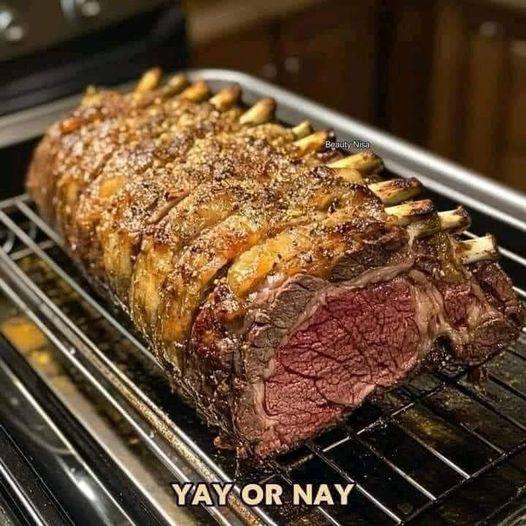ADVERTISEMENT
—
### **Instructions:**
#### 1. **Preparation Is Key**
Start by removing your prime rib from the refrigerator at least **2 hours before cooking** to allow it to come to room temperature. This ensures even cooking and helps avoid a cold center. You’ll also want to preheat your oven to **450°F (230°C)**. A hot oven is crucial for getting that initial sear.
#### 2. **Season the Prime Rib**
Next, it’s time to create the flavorful rub that will give your prime rib that incredible crust. In a small bowl, combine the **olive oil**, **garlic**, **rosemary**, **thyme**, **Dijon mustard**, **kosher salt**, **black pepper**, **onion powder**, and **smoked paprika**. Stir the mixture until it forms a paste-like consistency.
Rub this mixture all over the prime rib, making sure to cover the meat evenly. Don’t forget to get some seasoning between the bones if your roast is bone-in. The seasoning will create a flavorful crust that locks in juices and enhances the richness of the meat.
#### 3. **Sear the Roast**
Searing the prime rib before roasting is an essential step to developing a deep, flavorful crust. Heat a heavy skillet (preferably cast iron) over high heat and add a bit of oil. Once the skillet is hot, carefully sear the prime rib on all sides for **2-3 minutes per side** until it develops a beautiful brown crust. This should only take about 10-15 minutes, but it’s worth the effort.
#### 4. **Roast the Prime Rib**
Once seared, transfer the prime rib to a **roasting pan** (bone side down). Add the **beef broth** to the bottom of the pan—this helps keep the roast moist while also creating a flavorful base for your gravy later on. Place the pan in the preheated oven and roast for about **15 minutes at 450°F** to get a nice sear, then lower the temperature to **325°F (165°C)** and continue roasting for **about 15 minutes per pound** for medium-rare. For a **6-8 lb roast**, this will take approximately 1.5 to 2 hours, depending on your desired doneness.
To check for doneness, use a **meat thermometer** inserted into the center of the roast. The internal temperature should read:
– **120°F-125°F** for rare
– **130°F-135°F** for medium-rare
– **140°F-145°F** for medium
– **150°F-155°F** for medium-well
Remember, the roast will continue to cook while it rests, so aim to pull it out about **5-10°F before reaching your target temperature**.
#### 5. **Rest the Roast**
Once the prime rib reaches the desired temperature, remove it from the oven and let it rest, **covered loosely with foil**, for at least **20-30 minutes**. This resting period allows the juices to redistribute, ensuring a tender, juicy roast that slices beautifully. Don’t skip this step!
#### 6. **Carve and Serve**
After resting, it’s time to carve the prime rib. Use a sharp knife to slice between the bones, creating perfectly portioned servings. Serve the roast with your favorite sides, such as mashed potatoes, roasted vegetables, and perhaps a homemade au jus or gravy made from the pan drippings.
—
### **Why This Prime Rib Recipe is a Must for Christmas:**
– **Flavor Explosion**: The combination of fresh garlic, rosemary, thyme, and mustard creates a bold, aromatic crust that perfectly complements the rich, tender meat. Each bite is bursting with flavor, making it the star of your holiday feast.
– **Impressive Presentation**: Prime rib is the ultimate showstopper. Serving a massive, perfectly roasted prime rib at the center of the table will instantly elevate the festive atmosphere and make your guests feel like they’re part of something truly special.
– **Perfectly Cooked Every Time**: Thanks to precise cooking times and a simple yet foolproof technique, this recipe ensures that your prime rib comes out perfectly cooked to your desired doneness. No more guessing or overcooking the meat!
– **Easy Cleanup**: The beef broth in the roasting pan helps keep the prime rib juicy while also creating a base for a delicious gravy, making cleanup easier and giving you an extra tasty addition to your meal.
– **Versatile Pairings**: This prime rib pairs wonderfully with a wide range of sides, from creamy mashed potatoes to a tangy horseradish sauce. You can customize your meal with your favorite accompaniments, making it a meal that fits your family’s tastes perfectly.
—
### **Tips for Success:**
– **Use a Meat Thermometer**: A meat thermometer is your best friend when cooking a prime rib. It takes the guesswork out of the equation and helps you achieve that perfect level of doneness.
– **Low and Slow After the Initial High Heat**: Roasting at a lower temperature after the initial sear ensures even cooking, with a tender and juicy interior and a crispy, flavorful crust.
– **Rest the Meat**: Don’t rush the resting period! Letting the prime rib rest is essential for juicy, tender slices.
– **Make the Gravy**: Don’t forget to use the flavorful pan drippings to create an easy and delicious gravy. Simply simmer the drippings with some broth and a little flour to thicken, and you’ll have the perfect sauce to accompany your prime rib.
—
### Final Thoughts:
This **Prime Rib Recipe for Christmas** is more than just a meal—it’s an experience. The rich flavors, tender texture, and beautiful presentation make it the perfect choice for your holiday feast. This recipe is one you’ll want to keep handy year after year to make sure your Christmas dinner is always memorable.
So, what are you waiting for? Get that prime rib in the oven and get ready to wow your family and friends with a roast that’s sure to leave everyone asking for seconds (and maybe even thirds). Trust me, **don’t lose this recipe**—it’s a Christmas classic you’ll be making for years to come!
ADVERTISEMENT
